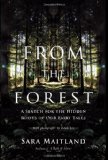 Gorgeous Description of Forests and the Origin of Fairy Tales
Gorgeous Description of Forests and the Origin of Fairy Tales
By Sara Maitland
Counterpoint Press, $28.00, 354 pages
Both the superb writing and the unusual topic distinguishes From the Forest as a wonderful, extraordinary book. Sara Maitland’s principal topic is fairy tales and how they originated. Since more than half of our Western European fairy tales involves forests (a place to hide in or a chaotic, scary place to be lost in), forests are the secondary focus. In Maitland’s introduction discussing her main topic we learn something we haven’t thought of: a fairy tale’s setting depends very much on the location of the story teller. The landscape, the seasons, the terrain and the creatures around determine how the characters interact in that particular landscape. We don’t come across forest settings in The Arabian Nights and we don’t find dessert creatures in German and Viking fairy tales.
Maitland divides her book into twelve neat chapters according to the seasons, starting in March and ending in February. Each month she picks an English or Scottish forest, and beautifully describes its natural setting, while also discussing fairy tales and everything about them. Her outstanding nature writing reminds us of our own Henry David Thoreau of Walden Pond. Since the forests are entirely in the UK, it would have been nice if the reader was provided with a map to give perspective. No doubt, British nature lovers would benefit more from the settings familiar to them but we can also profit enjoying this book even if we don’t know their geography.
“Gradually I came to recognize that the best fairy stories are very ancient and originally oral and that you are allowed to retell them at whim and in your own way.”
While she discusses the many nuances of each forest and its fauna, her own feelings and personal impressions, she also discusses fairy tales including their historic settings (with superscript numbers referring to her notes and references at the end). She pairs each month with a shorter section, a fairy tale of her own, a modern version, complete with adventures of a hero and heroine, the stories’ morale and, often, a happy ending. These are thought-provoking readings. Some share the title of known fairy tales (such as Rapunzel) but changed settings and characters.
An interesting example is “The Dream of the Sleeping Beauty”. When the beautiful princess pricks her finger in the tower, she falls into a deep sleep for one-hundred years. Each dream, lasting for a year, is described starting with a wall of ice scouring down trees (ice age) and continuing the warming up period, French king claiming the English throne and so on until modern times. And when the prince wakes her at the end of the hundred years, they will, naturally, live happily ever after.
Fairy tales were originally verbal stories, short and memorable. Not until two German brothers, the Grimm brothers, collected them, and written them down in 1812 and published the first published version that nearly all of us enjoyed to listen to and read when we were young. Totally different but also well-loved are the Arabian Nights in their desert settings. We also learn about the much controversy that surrounded the publication of the Grimm fairy tales. They changed the tales to be more Christian and family oriented, less sexual but more sexist and very, very nationalistic. Fairy tales are often re-written to suit modern times. They are a significant addition to our folk heritage especially so since today we lost our ability to tell a good story.
Each chapter is illustrated by a beautiful black-and-white photograph of Maitland’s son, Adam Lee.
Reviewed by George Erdosh
[amazon asin=1619020149&text=Buy On Amazon][amazon asin=1619020149&text=Buy On Amazon&template=carousel]
